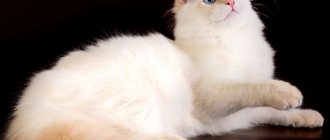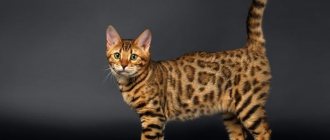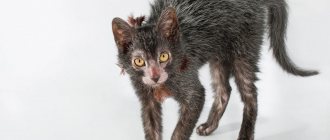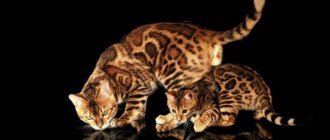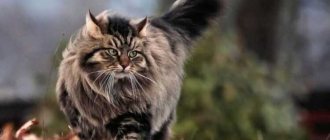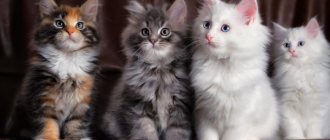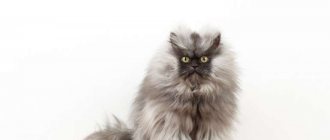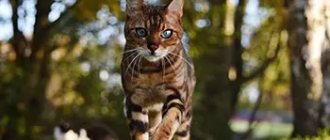Tabby cats are especially loved and most popular among furry pet lovers.
By the way, according to biologists, it is this color that makes cats cats. And indeed, if you turn your attention to the animal world, you will never see tiger stripes on anyone else. And according to popular belief, mustachioed and striped animals bring good luck to the house and make the owners more resilient in the face of life’s difficulties. A tabby cat fills the house with comfort and warmth
Genetics of tabby cat color
Tabby color, i.e. The coat pattern, of which the mackerel (tiger, striped) is a subspecies, is caused by the dominant T gene (Tabby), located on chromosome 1B. Of all the mammals living on our planet, it is characteristic only of the cat order.
This color is also called wild, since the very first cats on earth had it. It is characterized by the fact that darker spots and lines are located on a light background.
There are four types of such colors based on the phenotype of the dominant gene (allele):
- Tm - tiger pattern or mackerel, i.e. pure striped;
- Tb - marbled color, classic;
- Ta - agouti, ticking (in Abyssinian cats);
- Spotted Tabby (spotted tabby) - a spotted pattern, this is a polygenic color, a combination of several genes is responsible for it.
All cats, without exception, are carriers of the T gene, but if a recessive gene that blocks ticking (non-Agouti) is present in the animal’s phenotype, then the stripes are not visually visible.
History of patterns on cat fur
In addition, the breeds that arose in such a natural way have excellent health and a balanced psyche, inherited from untamed ancestors who could only rely on themselves - on their own strong paws and the ability to hold themselves in them. So a significant portion of stripes are an excellent choice for those who do not have time to fuss too much with a cat; they are unpretentious and not spoiled.
We are accustomed to the fact that a tabby cat is grayish-brown in color, but there are many breeds with a wide variety of color types, and at the same time richly decorated with stripes, spots or marbled patterns:
- You don’t have to go far - the native Siberian cat, the most common in Russia, has many other colors in addition to gray-brown, including even red.
- What can we say about cats such as the Bengal - a specially bred breed, the result of crossing a wild leopard cat and domestic pets. The color variations of this breed are unusually rich, and there are all kinds of patterns on the coat: a cat can look like a real leopard, like a tiger, and even like a snow leopard - in the silver variation.
- In addition, we can recall a rare breed of cat called a toyger - as you might guess, this is a completely striped little “tiger cub”. This breed is also selective, that is, specially bred by man. The coat color of this “tiger” is golden brown.
The different patterns on the skin are actually caused by different alleles of the same Tabby gene. It is noteworthy that this gene can appear after several generations even in those breeds that should not have stripes.
Thus, there are both natural and artificially created breeds of baleen-striped. Such popularity must undoubtedly be caused by something. What attracts people to “patterned” cats?
Norwegian forest
A large, strong, muscular, very agile cat in a luxurious, very dense coat with water-repellent outer hair covering the back, sides and tail. Breed standards allow many colors, but tabby is one of the most common and, admittedly, the most “suitable” to their harsh appearance.
The ancestors of the Norwegians are feral domestic cats, inhabitants of the forests of Scandinavia for hundreds of years. How they got to those harsh lands is not known for certain. Research has only proven their relationship with Turkish Angoras.
The Norwegian Forest cat is not an old breed, although ideas about its selection appeared back in the 30s of the last century - when it became obvious that the cats of the Scandinavian forests were in danger of extinction. But the breeding program was developed only in the 70s, and was quite successful. Now Norwegians are recognized throughout the world and are the pride of Norwegian breeders (hence the name).
Short tail
It is noteworthy that the presence of a tail in a “rudimentary” state or its complete absence in cats is a sign of “noble” origin (in contrast to the same domestic dogs, whose tails are docked deliberately - to fit the animals to the standards of a particular breed). It is worth noting that there are only a few types of short-tailed/“tailless” cat breeds, which include:
Kurilian Bobtail
a short curved tail approximately 5-9 cm long, resembling a fluffy pom-pom and characterized by mobility, a relatively small body with strong bones, developed muscles and limbs of medium length, a triangle-shaped head with medium-sized eyes corresponding to the color, short-haired or semi-long-haired, but in in any case, with a fluffy collar on the neck and chest.
more details
American Bobtail
a short and flexible tail from 2.5 to 8 cm long (it can be straight, curved, and slightly curled at the end), a body of medium length with an athletic build and strong paws proportional to it, a round muzzle with strong jaws and ears, an internal the surface of which is covered with long fluffy hairs, short or long hair, but always thick and slightly harsh.
more details
Japanese Bobtail
a short tail no more than 12 cm long (straight, curled, curved or in the form of a pompom), a long and lean body with a flat back and slender legs (the hind legs are noticeably longer than the front ones), a muzzle with large oval-shaped eyes and large, wide-set ears, soft and silky coat of medium length.
more details
Mekong Bobtail
a short and broken tail with a length of at least three vertebrae (but no more than a quarter of the length of the body itself), a strong and muscular body of medium size with long legs, a wedge-shaped head with medium-sized ears (with rounded tips) and slightly slanted eyes, always bright blue , short silky coat with minimal undercoat.
Karelian Bobtail
a short tail 4-13 cm long (can be either kinked or almost straight), a strong body with an even posture and proportional paws, a narrow head with a small strong chin and rather large ears with tiny “tassels”, short or long hair ( necessarily dense).
Kurilian Bobtail
“no, not a relative”
short tail 3-8 cm long (with pronounced kinks), strong build with a slightly arched back and powerful paws, large trapezoidal head with a powerful chin and proportional ears, short or long hair (very soft to the touch).
more details
Pixiebob
short straight (but possible kinks) tail about 5 cm long, large and muscular body build with powerful bones and a clearly defined arch on the back, large pear-shaped head, tightly knit and strong paws (the hind legs are noticeably longer than the front ones), short or moderately long hair with different color options, but always with small or medium spots throughout the body.
more details
Manx cat
they may either have no tail completely, or have a small “stump” hidden under the fur, or generally have a tail of normal length, a medium-sized round body with a round head, powerful limbs with well-developed muscles (the front ones are noticeably shorter than the back ones), round eyes with a slight slant, short and thick coat, like “plush”.
more details
Cymric cat
Kymrik
tailless breed (but there can be either a “stump” or even a full tail), a tightly built physique with a wide chest and an arched back, short front and long hind limbs (with heavy shins), thick hair of medium length.
more details
Feature of striped color
In order for a cat to be tabby, in addition to the tabby gene, its chromosome set must also contain the Agouti ticking gene. In all such cats, each hair is colored in several dark and light shades, arranged in alternating patterns. Visually, this is perceived as lines and spots on the coat.
All ginger cats must have a striped pattern. The red color gene O, linked to the male chromosome X, suppresses the action of the recessive non-Agouti gene.
The tabby pattern can be tortoiseshell (tortie) cats and color-point animals.
Recent scientific research conducted by the famous geneticist Stephen O'Brien has led to the conclusion that the dominant T gene and the cat's immune system are related.
“A tabby is not a simple set of stripes and spots, it plays a more important role in a cat’s body” - this statement by the scientist formed the basis for his study of the relationship between tabby and animal immunity at the Scientific Center for Genomic Bioinformatics in St. Petersburg.
A distinctive feature of tabby cats is the letter “M” on their forehead. There is a biblical legend that it means the name of the Virgin Mary, since the mother of Jesus Christ stroked the head of the kitten lying next to her in the stable of Bethlehem on the night of the birth of the son of God.
Muslims believe that this is the first letter of the name of the Prophet Muhammad, since he loved cats very much.
What does color depend on?
The set of genes of any animal is a kind of puzzle, from which a future picture is created by forming a certain sequence of elements. It includes the color of the coat, the color of the nose, eyes, their frame and other external characteristics.
The mechanism of inheritance of parental characteristics occurs differently in each kitten (depending on which genes in the parents are dominant and which are recessive).
Important! There are no completely monochromatic ginger cats. They always have a tabby color (more or less noticeable).
In the formation of the main color of a cat’s coat, only one pigment plays a role - melanin, but in two of its varieties: pheomelanin (responsible for the predominance of the red tint) and eumelanin (showing shades of black). Nevertheless, the real picture is as follows: completely monochromatic cats are the exception rather than the rule, and the predominant and, most importantly, favorites in the household are spotted, brindle, or wearing “brown” cats.
It should be noted that it is this palette that reflects the true appearance and character of real cats (striped colors are the closest to the color of their ancient ancestors, this is what makes them feline). Eumelanin exhibits all shades of black, ranging from charcoal to lilac, and pheomelanin can be demonstrated in a palette from bright amber to soft beige. The first thing you must learn in order to find out the name of the breed of tabby cats: “tabby” is not a breed, but a peculiar color of a cat, and striped pets have different breeds. We have all seen brindle and spotted cats more than once, and those who wore beautiful patterns of color on their “clothes.” So: special genes of group T, which are found in all representatives of the cat world, are responsible for the formation of such an unusual pattern on the coat of cats. Their peculiarity is that they are activated only when interacting with gene A - it is this allele (in the dominant variant) that provokes the formation of zonal coloring on individual hairs or on the entire area of the coat.
Did you know? There is a legend according to which, after the long-awaited birth of Jesus in Bethlehem, a kitten came to the birthplace in the stable and began to walk around the manger. Then he lay down next to the baby and began to bask next to him, while the young mother stroked his fluffy head. After some time, the letter “M” magically appeared on the animal’s forehead, like the capital name of the mother of Jesus.
It is also worth noting that the “tabby” coloring is very popular among ordinary or yard cats. Among all the owners of this pattern, you cannot find two kittens with absolutely identical patterns: each of them has its own curls, mysterious and unique in its own way.
But all tabby cats have a mandatory condition, according to which their color belongs to this type. This feature is usually called the presence of the letter “M” on the forehead. Its manifestation can be very different depending on the color and shade of the wool hairs themselves, as well as on the size and intricacy of the shape. Among the main types of “tabby patterns” the following types and their characteristic features can be distinguished:
- tiger (mackerel) : narrow lines predominate, reminiscent in appearance of the ribs of a fish skeleton, appearing as peculiar narrow bracelets on the paws and tail, and as necklaces on the neck and chest;
- marble (classic) : there are dense, large curls and continuous lines throughout the body; while those that go from the back of the head to the shoulders resemble a butterfly in shape, and one or more rings on the sides are often called an “eye” or “rosette”;
- spotted : spots of different shapes and sizes are located on the body (these patterns are also called the “broken” version of the brindle or classic tabby due to the supposedly breaking stripes and curls);
- ticked : markings appear on the limbs rather than just the body, and each individual hair may be a different color at the same time.
Did you know? There is a belief among Muslims that the symbol of the letter “M” appeared on the forehead of tabby cats because the Prophet Muhammad loved these animals very much.
This is interesting: How to remove a catheter from a cat?
Kurilian Bobtail
A compact, muscular cat, with a slightly arched back, longer hind legs and a short (3 - 8 cm) twisted tail, which, due to its longer fur, has the appearance of a lush pom-pom. The wool is thick, with good water-repellent properties, but a weak undercoat. There are two breeds of Kurbobs, which differ only in the length of their coat. These are sociable, inquisitive, but independent cats, playful and affectionate.
As the name suggests, the breed has some relation to the Kuril Islands. It was there that the ancestors of the Kurbobs lived (and still live). At one time it was assumed that the gene for short-tailed cats living in the Kuril Islands is identical to the gene for Japanese bobtails, a long-existing breed. This version was logical, because Japan is very close. But then it turned out that this was not the case, and cat fans have the opportunity to admire another bred breed.
Pixie bob
Another breed that has a wild disposition. It is the result of crossing a domestic and wild cat. The name of the breed literally translates as “short-tailed elf.”
These cats are quite large - the weight of males reaches 8-10 kg. Interestingly, representatives of the breed have polydactyly - more fingers than necessary.
However, this is not considered a disadvantage. In addition, such individuals are more resilient and have good health. The most common color is black or brown stripes on a light background.
The pixie bob has a massive, pear-shaped head. Due to the growth pattern of the coat, sideburns are observed. The ears are medium in size and have tufts at the tips. The paws are powerful, each paw can have up to 7 toes. The eyes are wide, the brow ridges are well defined.
The length of the tail does not exceed 5 cm. The Pixie Bob is a long-haired breed. The length of the coat can exceed 5 cm.
Like dogs, pixie bobs follow their owners everywhere. They love active games, swimming and walks. They don’t play pranks and don’t impose themselves. They are easy to train. They get sick extremely rarely.
TOP 14 most striking representatives of the striped color
Almost all cats are tabbies, except for breeds that have a solid or solid color. These are Chartreuse, Russian Blue, Nibelung, Bombay cat, Balinese and some others. There are breeds that are bright representatives of the striped color.
Toyger
This breed is essentially a subspecies of the Bengal. For a Bengal cat, the merging of spots into continuous stripes is unacceptable and serves as grounds for disqualification.
The consolidation of this culling factor led to the formation of a new cat variety with a brindle pattern. In English-speaking felinology it is called mackerel.
This strong and energetic pet is no different in personality from the Bengal.
Read more in the article about toygers.
European Shorthair
Celtic cat is the second name of the breed. This naturally occurring variety has a strong, muscular body. He has a calm and friendly character. It is undemanding in maintenance and care.
Siberian cat
Animals with a strong and powerful body and a luxurious fur coat with undercoat are carriers of a very healthy immune system. This natural breed was formed in Siberia over many centuries.
Wonderful hunters and home protectors with a variety of numerous colors are always tabbies. They are distinguished by stripes on the paws and tail, round spots on the stomach and a clearly drawn letter M on the forehead.
By nature, these are very calm and serious animals that do not like excessive care. Long hair requires some care, especially during the shedding period.
Read more in the article about Siberian cats.
American Shorthair
These cats, which descended from their European counterparts, came to America with the first settlers. Adapting to new, harsh living conditions, the animals became larger in size and stronger, more muscular. The American coat is coarser and denser, with a well-developed undercoat.
The colors are varied - solid, shaded and tabby. The most famous, beloved and widespread type is the American cat with a classic marbled color.
These sociable but independent pets adapt well to any living conditions. They are smart and easy to train. They obey their household members and consider it their duty to care for and protect everyone living in the house.
The short and dense coat requires virtually no maintenance. The health of these cats usually does not cause any concern to owners.
Also read the article about American Shorthair cats.
Bengal
These hybrid animals always carry the Tm or Tb allele. Polygenic combinations produce the spotted tabby color. All cats have bright stripes and spots on their bodies, paws, tails and bellies. In this case, the main background can be different - gold (red), silver (gray), white (snow colors), black (black).
Bengal is a very mobile and active animal. Attached to the owner, an eternal child who will play all his life. Suffering from loneliness.
If it is not possible for one of the household members to always be in the house, then it is better to get another pet with the same lively and restless character.
The Bengal owes its dazzlingly beautiful coat with soft shiny fur to its wild ancestor - the Asian leopard cat (or Lesser Asian leopard). ALC, along with Ocelot and Margay, is the most striking representative of the tabby color in the world of wild cat species.
American Bobtail
The breed originated in the United States of America. Her ancestor was a homeless tabby kitten from the Arizona Indian Reservation.
These short-tailed animals come in different colors and types, but the tabby pattern remains the most common and beloved.
The character of the pets is calm and flexible. At the same time, they retain their love of freedom and independence. Smart, intelligent, even trainable. They are unpretentious in care and nutrition.
Read more in the article about American Bobtails.
Cymric
The long-haired beauty is distinguished by complete taillessness and a strong, muscular, fairly large body.
The double coat has a powerful undercoat, so the animal visually appears even larger. Comes in various colors. But tabby coloring is the most widespread.
These hardy, loyal and affectionate animals will never allow themselves to offend children. They are one of the best breeds for home keeping.
More about the Cymrics.
Soukok or sokoke
A small cat with a dry type of muscles is the bearer of a special unique color, which is called “soukok-tabby”.
This natural breed was discovered in Kenya, in the town of Soukok.
The color variations of the wool are varied, but the pattern is always marbled, in the form of large rings and “rosettes” of various sizes.
As a domestic variety, it is still a very young breed. Only twenty animals are registered in the fifth generation.
Good-natured pets are very active, cheerful and restless. Lovers to “talk” and play, are very smart and independent. They get along well with everyone, but it is better to have a cat of the same breed as a companion. They need large spaces to play and love to swim.
Read more in the article about the Sokoke breed.
Maine Coon
A native breed from the American state of Maine, it is distinguished by its large size, long, dense coat with a well-developed undercoat and independent character.
There are many legends about the origin of the variety. Maine Coon literally means “raccoon from Maine.” The second most popular breed in the United States.
The colors of the long coat can be different - solid, smoky, tortie and tabby. Although there are experiments on breeding coons and color-point colors, the so-called Si-coons.
These animals are calm, reserved, self-confident, independent, but good-natured. They require daily care and increased attention to health.
Norwegian forest
A strong and robust animal with a characteristic and recognizable body shape. Good health, excellent muscles and a long double coat with water-repellent properties are what allowed this cat to survive and adapt to the harsh Scandinavian climate.
This is the only cat that can climb down a tree trunk with its face; no other domestic breed has such powerful claws.
Tabby is one of the most common colors of the Norwegian.
The character is calm and reserved. The animal does not tolerate loneliness well and becomes strongly attached to humans.
Exotic
The exotic cat's body structure is completely reminiscent of the Persian. This breed was bred as its short-haired variant.
Among the many colors of Exot, tabby is very popular and loved.
These calm and unpretentious animals are generally recognized throughout the world as the most affectionate and loyal. The best pet option for families with children.
Asian tabby
The breed was artificially bred in the 1980s. The color of the coat can be different - black, red, chocolate, blue, cream, lilac, caramel, apricot. But the color is only tabby.
Calm and good-natured pets are very sociable and devoted to people. They get along well with any animals and are quite silent.
Pixiebob
This young variety is gaining worldwide popularity every year. First of all, because of his wonderful character. Although the exotic appearance also matters.
Pixie means “fairy-tale elf” - that was the name of the first representative of the breed. Bob - short ponytail.
These are animals with the appearance of a lynx and the character of an angel.
Active and energetic pets are completely unobtrusive and at the same time pathologically devoted to their owner. Very smart, inquisitive and sociable. They can easily learn to perform simple commands.
Read more in the article about pixie bobs.
British breed
British dogs come in different colors - both solid and tabby. Striped colors are very diverse in their color variations. They are divided into marbled, brindle and spotted (spotted) type according to the nature of the pattern.
Cats have the character of true English lords, they are very reserved, independent and proud.
We also recommend reading the article about British shorthair, longhair and fold cats.
Breeds that are proud of their stripes
And yet, the palm should be given to the family of cats, which is popularly called the Noble family. It is impossible to describe the external characteristics: they are all different, the color of the coat varies from black striped to white speckled with gray striped spots. Yes, and physical characteristics are also different. Some are strong, some are graceful. Gray striped cats of the noble “breed” also have common characteristics. For example, they are considered the hardiest cats. There is one more thing that gray tabby cats have in common. If they are brought into the house, put in order and begin to take care of them, then they become very devoted to their new owners.
Names of other domestic breeds of gray tabby cats:
- British;
- European Shorthair;
- Toyger;
- Bobtail.
Tabby cats of each breed have characteristic features that are characteristic of their family:
British . These are strong, medium-sized cats with a round muzzle. They are smart and playful. The gray color of their coat is called tabby.
© shutterstock
European Shorthair . A strong cat, large, but incredibly graceful. Independent character. Its dark gray stripes most often decorate its gray and brown coat. There are also spotted colors of the breed.
Toyger . The muscular body of this tiger cub fully corresponds to the characteristics of a real tiger, only in miniature. The heart-shaped face, slightly rounded ears, especially fluffy chest, strong paws are in full agreement with their “relatives” along the line of predators.
Bobtail . Several varieties of bobtails share common characteristics: a muscular build, long, strong hind legs and a short, stubby tail. These gray-black-striped faces are incredibly friendly and good-natured.
Character of outbred minke whales
The behavior of representatives of certain breeds is directly related to their roots and heredity. What then is the character of the ordinary tabby cats that live in our yards and, of course, in apartments?
Overall, a simple gray tabby cat can be a real test of strength. He is extremely inquisitive, independent, cheerful and active. And the mixture of these qualities speaks only of one thing - you shouldn’t expect much peace from such a pet. But at the same time, this cat is very smart and understanding, and some prefer to defend their point of view, entering into an argument with the owner and repeating the same act over and over again.
Tabby cats can hardly be called obedient, but at the same time they accept punishment with understanding and never take revenge for fair punishment. But it is useless to conduct educational conversations with such pets - for some time they will look you in the eyes with a smart look and show that they understand everything and are aware of how bad the action was, but after a few seconds they will turn around, cutting off your tirade mid-sentence.
Instructions and rules are not for a tabby cat - she always does what she considers necessary
All owners of tabby cats know that their pets are always mischievous and under any circumstances. However, they are endlessly cute and are characterized as extremely cheerful animals. You are guaranteed not to get bored with your striped pet, but you should remember that he easily gets excited, and therefore it is important to stop him in time. Otherwise, too much activity can lead to unpleasant consequences, such as torn wallpaper, tulle torn from the cornice, etc.
The tabby cat rests wherever she pleases. And even if you buy her the most beautiful and comfortable house, it is far from a fact that she will sleep in it. Such a pet chooses its own place to rest; it could be your favorite chair, your sofa or a pillow on your marital bed. And once a tabby cat makes its choice, it is extremely difficult to retrain it. You come to bed, carefully carry your seemingly asleep pet to a place specially designated for him and lay down in your bed, fall asleep... open your eyes, it’s the middle of the night, and your pet is snoring peacefully under your nose, as if he never left.
Games... tabby cats can spend an infinite amount of time on this. But don’t rush to buy your pet any special balls, colored mice or other expensive teasers. They prefer to play with the simplest things: pencils, fallen leaves from a flower on the windowsill, apples that you just left in the kitchen, as well as cups and even plastic bags. Tabby cats are quite picky in this regard and are capable of chasing the chestnut you brought from the street around the apartment for hours on end, and completely not paying attention to expensive toys. Believe me, the latter will most likely constantly gather dust in the corner.
On a note! However, here you should remember that flower pots will often end up on the floor, and ballpoint pens will begin to disappear without a trace from your desktop!
Diet of British tabby cats
Proper nutrition directly ensures the beauty of your pet's coat. Cats need vitamins, minerals and other beneficial elements.
You can buy ready-made food, but only of the highest quality. Depending on age, gender, taste preferences, the type of food is selected. If you decide to feed your pet yourself, remember the permitted products:
- lean meat and offal;
- boiled low-fat fish;
- quail eggs;
- any porridge;
- sprouted cereals;
- grass for cats.
Food intended for an adult animal should not be given to a small kitten. You need to give up pork completely. Poultry or rabbit are best suited for complementary meat. Dairy products should be as low-fat as possible; sugar should be excluded. It is not always possible to pre-treat foods. Sometimes it’s worth pampering with raw vegetables and meat products.
Don't forget about water. A bowl of clean water should always be visible. Make sure that no pieces of food or other debris get into the water.
The health of your four-legged friend comes first. A strong immune system allows British cats to get sick much less often than other members of the cat family. They have two weaknesses - draft and cold. This is worth considering when choosing a personal place for your pet.
This breed is least likely to suffer from cancer, and with proper care it reaches a very old age. It has been documented that castrated cats live longer than their counterparts.
"Classics of the genre
If the owner is not particularly concerned about finding a rare, original name for his mustachioed-striped pet, then you can limit yourself to a list of the most common cat names:
- Barsik;
- Boris;
- Vaska;
- Basil;
- Kuzya;
- Kuzma;
- Kotofey;
- Marquis;
- Murzik;
- Semyon (Semka, Semushka);
- Stepan (Styopka, Stepashka);
- Timofey;
- Timka;
- Tishka;
- Timosha;
- Filya;
- Philemon.
In principle, most domestic cats have a similar color, so traditional nicknames suit them perfectly.
Appearance of striped pets
Among felinologists, tabby cats are also called tabby cats. Pets that are dark, brown or gray with stripes have strong immunity and are less likely to get sick. According to research results, it has been proven that the gene that is responsible for the spotted-striped color has a close relationship with immunity. For this reason, barn cats and mongrel cats live long.
Seals and adults who have brown, gray-white and other striped cats can have different patterns and shades. Some pets have a striped chest, and the tail may be a single color. Another purebred cat has a basic dark coat with white or red stripes. This color is typical for expensive breeds of the cat family, and simple, yard cats often have stripes. A pet's stripe does not indicate thoroughbredness, but is only a type of color. Most of these animals have a pattern on their forehead that resembles the letter “M”.
Modern "words"
Against the backdrop of changes in science and technology, new, sonorous words are increasingly appearing in the modern lexicon. They can also be used as a nickname for a tiger kitten:
- iPhone;
- IP;
- Agile;
- Byte;
- Blogger;
- cue ball;
- Wi-Fi;
- Virus;
- Gamer;
- Dumping;
- Internet;
- Like;
- Mail;
- Laptop;
- Pixel;
- Picture;
- Pitch;
- Samsung;
- Website;
- Smartphone;
- Trend;
- Hustle;
- Hype.
British, Scottish
The plush silver tabby cats from the Whiskas ad created a real sensation! Of course, this is not the only color in the breed - any coat color can be decorated with stripes or marbles. Interesting brindle brindles, densely painted with narrow “dashes”.
The Scots and British are moderately sociable and can easily tolerate loneliness. Stiffness is a breed trait and is not a fault. They are loved for their royal arrogance and some disdain for people. The trust and tender affection of these cats are worth a lot. Calm, intelligent, clean - ladies and gentlemen!
Is there a yard breed?
The very concept of “breed” is very young – it is no more than 200 years old. Felinological organizations identify special traits and properties in individual cats, then prescribe and approve a standard with these unique characteristics, thereby giving the world a new purebred beauty.
Felinologists call yard cats outbred, although this statement can be considered erroneous, because the ancestors of all purrs were wild cats, which have different external characteristics and character, which is explained by different climates and ability to adapt.
Thus, native breeds with characteristic external data and character traits can be called yard breeds, because the distinctive characteristics of these purrs were formed thanks to nature, without the “selective” hand of man.
These native barn cats include:
- Turkish Angora.
- Celtic cat.
- Persian cat.
- Siberian cat.
- Siamese cat.
BRITISH MARBLE COLOR (MARBLE)
The British merle color is a very bright, beautiful color, perhaps the most complex in the tabby series. Marbled British cats wear beautiful patterns on their backs (2 stripes along the ridge, closed large circles on the sides, inside of which there is a clear large painted spot. And this entire pattern should not intersect or be interrupted. Also, a British marbled tabby cat has a butterfly pattern on the back of its head, patterns on the cheeks, starting from the corners of the eyes, on the forehead the letter "M". In addition, the British marble cat has closed "necklaces" on the chest (the larger the better), clear rings on the paws and tail. The British marble cat is very valued among breeders for its beautiful design, especially if the color is drawn correctly.
A British merle color may not be contrasting, in which case the color is rejected.
Photo: British cat Emili black marble on gold BRI ny 22 64
The character of the British marbled cat is no different from all other colors, although often future owners are interested in it, thinking that it is a separate breed of cat.
The marbled color of British kittens is visible from birth and is already quite contrasting. The necessary stripes, circles, and rings are clearly visible. The pattern of a British marbled kitten (British marbled kitten) may blend in a little with the main color of the coat, do not worry, most often by 2 months everything evens out and the color becomes most expressive.
Russian blue
Russian Blue Unlike the Siberian, the Russian Blue cat has been known since the time of Catherine the Great. Previously, this breed was called the Arkhangelsk Blue, which indicates the location of its homeland - Arkhangelsk.
At the beginning of the 20th century, the Arkhangelsk port was often visited by British sailors. They really liked the local purrs, so they took several cute pussies with them and took them to England.
Local breeders were clearly delighted with the even, silver-blue coat and deep green eyes of their owners. Cat lovers began to work with great diligence and improve this breed of cats, which was later called the “foreign blue”, in general
NEVSKAYA MASQUERADE CAT.
TOP 10 popular varieties
Often the tabby or piebald color of a cat is mixed with snow-white. The one-color tone is a kind of “knee socks” on the legs and spots on the belly. The tiger color occupies exactly half of the body, the rest is covered with white.
- Clouded Leopard - The image is similar to lynx fur and resembles marble in combination with a steel color.
- Silver (silver) implies a dark image on a snow-white color.
- Rosette - a variation of piebald coloring, visually the spots resemble rosettes. Most often found in the Bengal breed.
- Blue - a grayish or azure pattern on light wool.
- Brown is distinguished by a dark outline on a red-brown color.
- Black silver is characteristic of the British breed. The main color is silver with black outlines.
- Sil - found mainly in the Thai breed. Pale chestnut spots are located on a cream color.
- Blue, chocolate, lilac, cream, golden points are found with corresponding colors on a pale, light background.
- Red – stands out because the background color is peach.
- Chocolate in Silver – based on a silver-blue background with chocolate outlines.
Strengths of mongrels
Each purebred cat is unique and valued for some of its exceptional characteristics. Yard mustaches may in some ways not be comparable to their purebred counterparts, but they have a lot of advantages:
- Health. The life expectancy of mongrels is usually longer than that of purebred purrs, because the former have a stronger and more lasting immunity to most street infections. Selection work weakens the protective functions of the cat’s body.
- Temperament. Domestic breeds have the most flexible and gentle character. If such a cat is picked up on the street, then its joy will know no bounds - it will become attached to its owner for life.
- Knitting. Finding a partner for a yard pet will not be difficult. Most likely you will have many options to choose from. Waiting for a new offspring is always a mystery, because it is impossible to predict what coat color, color and eye shape the future kittens will have. It is quite possible that such a kitten will become the founder of a new breed.
- Help with housekeeping. Catching an annoying rodent will not be difficult for a mongrel; they have a well-developed natural instinct.
- Exhibitions. There are exhibitions for outbred pets, where the external characteristics of purrs and their grooming are assessed. It’s great that yard breeds also have the opportunity to show themselves in all their glory.
- Price. Anyone can buy a yard pet. Usually they come to visit themselves, offering to leave themselves. In this case, it is almost impossible to refuse.
Fun and playful
In a house where people with a healthy sense of humor live, a pet with a very funny name may appear. The nickname and its owner will evoke exclusively positive emotions:
- Anchovy;
- Adonka;
- Afonka;
- Aspirin;
- Bubble gum;
- Big Mac;
- Bentley;
- Bon Bon;
- Tailless;
- Wasabi;
- Grumpy;
- Winky;
- Glitch;
- Dwarf;
- Grizzly;
- Decl;
- Doodle;
- Dobby;
- Don Baton;
- Brownie;
- Brownie;
- Homer;
- Hare;
- Nerd;
- Zyama;
- Kiwi;
- Sidekick;
- Korzhik;
- Yeti;
- Carlusha;
- Koschey;
- Kulichik;
- bobtail;
- Kuska;
- Leys;
- Goblin;
- Luntik;
- Lapsus;
- Lapis;
- Lemon;
- Mityai;
- Murmured;
- Nafanya;
- Ninja;
- Paprikash;
- Pate;
- Dodger;
- Bobblehead;
- Pipito;
- Little lynx;
- Santa;
- Scooby Doo;
- Skunk;
- Synoptic;
- Meerkat;
- Gopher;
- Tungus;
- Ushastik;
- Phantom;
- Fantômas;
- Date fruit;
- Chizhik;
- Chips;
- Chubchik;
- Schnapps;
- Shunya;
- Nice;
- Screw;
- Iago.
History of domestication of cats
The history of relations between humans and cats goes back several thousand years. Ancient chronicles and archaeological finds testify to this amazing neighborhood.
For a long period, scientists believed that the first who managed to domesticate cats were the ancient Egyptians. This conclusion was made after studying one tomb, which was built in 1950 BC. There were corresponding images on the wall paintings. However, studies of Cypriot burials in 2004 refuted these claims. The tomb, which dates back to about 9,500 BC, contained the remains of a man and a cat.
In ancient Egypt, these animals were given special attention. They were treasured because they helped people get rid of mouse infestations. The Egyptians considered cats to be sacred animals. In the Middle Ages, attitudes towards them were ambiguous: in some countries cats symbolized kindness and tranquility in the home, while in others they were credited with magical properties and connections with evil spirits. Animals were especially widespread in some countries of Europe and North Africa, as well as in Russia, Japan and China.
In those ancient times, people did not attach much importance to cat breeds. This concept came into use about 200 years ago, when the rapid development of such a science as selection began.
On the territory of modern Russia, yard cats and cats appeared during the formation of Ancient Rus'. The breeding of purebred groups began only in the second half of the 18th century. In those years, the most popular breed was considered the Russian Blue, presumably bred in Great Britain.
Maine Coon
Coons are amazing in size! The long coat with a thick undercoat requires daily grooming. There are many colors, but tabby cats are popular for their resemblance to the aboriginal farm cats. Contrary to established legend, this is an artificially bred breed that has more than a dozen serious hereditary problems in its genotype.
Coons have a good-natured character, if you act through affection. They do not tolerate coercion, they can let out their claws, although they try to just leave until the last moment. Coons are very smart and brave, they become attached to their family and are indifferent to strangers. They are patient with children and dogs, but you should not leave them with small animals.
Cymric
The cat is originally from England and looks like a bobtail. She has a very short tail, but there are a lot of nerve endings on it. Sometimes even a normal touch causes discomfort or pain to the cat. The character of the Cymric is similar to that of a dog: they love to bathe, bring a ball and store supplies: they bury toys and treats. If desired and treated with kindness, this breed is easy to train. A cat can be taught a variety of tricks.
Kymrik cannot stand loneliness . Without his owner, he gets bored and depressed . Therefore, if you disappear all day at work, this breed is not for you. The owner will also have to take into account the characteristics of the cat and handle the mini-tail area very carefully.
Cymric cats can come in a variety of colors. The photo shows a tri-color gray and red tabby cat:
Signs about mustachios and stripes
One of the main signs associated with patterns on a cat’s body says that meeting a tabby cat means imminent changes. The nature of the changes can be determined by taking a closer look at the frequency and brightness of the stripes, and most importantly, their color:
- Red stripes mean that only the appearance of change awaits you, and all events associated with them will lead nowhere.
- But black stripes are a reason to be wary. Perhaps you are not moving in life in the best way.
In addition to the color of the stripes themselves, you need to pay attention to the color of the tip of the tail - if it is white, then it is a good sign, you can safely make a wish and go towards the goal. As for the house where the tabby pet lives, money will not be lost here, because such cats bring good luck and wealth
And if you picked up your minke whale on the street, then your home will become completely happy, because sheltering an orphan is the best omen of all
As for the house in which the tabby pet lives, money will not be lost here, because such cats bring good luck and wealth. And if you picked up your minke whale on the street, then your home will become completely happy, because sheltering an orphan is the best omen of all.
Author of the article: Alena Oleynikova, artist and cat lover, especially for Kota Obormot
Maintenance, feeding and care at home
Outdoor cats are easy to care for. They need to be cared for in the same way as purebred pets:
| Hygiene procedure | Frequency of execution | Recommendations |
| Combing | 1–2 times a week | You need to comb your tailed friend with a special rubber brush-mitten. |
| the washing up | As the wool gets dirty | Bath cats with pet shampoo. |
| Cleaning the ears | 1–2 times a week | Natural secretions and dust are removed with a cotton pad moistened with warm boiled water or a special solution. |
| Eye cleaning | ||
| Teeth cleaning | As plaque forms | A special toothbrush and toothpaste are used. |
| Nail trimming | As it grows | The claws are shortened with a special claw cutter. |
To comfortably accommodate a mongrel animal, you need:
- arrange a sleeping place for him in a warm, quiet room, where there are no drafts;
- tray with or without filler;
- scratching post;
- bowls for food and water;
- walking harness;
- play complex and (or) toys.
Nuances of care
In general, tabby cats require the same care as pets of any other color. So, first of all, the care and maintenance of an animal should be based on the characteristics of a particular breed. However, there are general rules that must be followed if you are the owner of a tabby cat of any breed or variety.
First you need to take care of arranging a place for the cat. Today on the zoological market you can find a variety of beds for sale that will be an excellent place for an animal to rest. If desired, you can make such a lounger yourself. In addition, the cat absolutely needs bowls of food and water. The diet and water balance of a particular animal depends on its breed. Another necessary detail is a tray that will serve as a toilet. From the very first days, accustom your animal to the tray to avoid various unpleasant situations. And also, as the pet ages, it will need a special device with which it can sharpen its claws.
Hygienic procedures are also a mandatory care measure. Cats need to be bathed periodically. This should be done in warm water and using only those detergents that are specifically designed for cats (they can be purchased at any zoological store). In addition, do not forget to regularly brush your cat's hair, especially for breeds that have long hair. It is also necessary to trim the animal’s claws regularly.
If you do not purchase such an item, the cat will sharpen them on furniture, walls and other household objects, thereby violating their integrity.
Do not forget about preventive and medical measures. So, first, take care of your vaccinations. And also remember to regularly treat your cat for worms, fleas and other harmful microorganisms. At least once every six months, show the animal to the veterinarian, and at the first manifestations of the disease, immediately go to the veterinary hospital, and under no circumstances self-medicate.
Also, consider the behavioral characteristics of the breed. For example, some species need to be outside for walks (in this case, you will need to purchase a leash and schedule walks); other animals, on the contrary, love peace and quiet, so you should not constantly try to pick them up or play with them.
Tabby cats are quite popular pets. A distinctive feature of animals with this coloring is stable immunity, because striping and the quality of immunity are controlled by the same gene. The choice of a specific striped animal that will become a full-fledged member of your family should depend on a large number of different factors: appearance, color option, breed, and so on. But remember that by choosing an animal and placing it in your home, you take full responsibility for its life and health, so try to follow all care recommendations and maintenance instructions. In this case, you will ensure the animal a long, healthy and active life, and you yourself will receive a loyal and reliable friend.
For more information on the behavior, maintenance and care of the British tabby, see below.
Breeds of black and white cats
For a long time, the black and white color remained unrecognized by felinological systems, and purebred cats with a similar color were mercilessly discarded. The situation changed in 1969, when animals with such coats first appeared at the exhibition. Now black and white cats are found in many breeds.
British
For a long period, only blue or smoky colors were cultivated in the breed. But with the popularization of the British, their color range expanded significantly.
In addition to the standard types - van, harlequin and bicolor - among the black and white cats of this breed there are individuals with the unrecognized mitted color. It requires the presence of a light stripe between the chin and groin.
Also, black and white cats of the British breed with a mitted color should have light “socks” or “socks” on their paws.
Oriental
The standard of this breed provides for more than 200 colors, including all black and white variants. Moreover, a van, bicolor and harlequin kitten can be born in one litter. There are many varieties of black and white cats in the breed.
Among the Orientals there are also charcoal individuals with light paws and markings on the face, and snow-white animals with small contrasting spots.
Canadian Sphynx
Bicolor cats are often found among cats of this breed. Moreover, a contrasting pigment colors the skin. Black and white cats of this breed often have a charcoal tail and at least one ear. Sphynx cats are also allowed a symmetrical dark marking on the top of their head.
Kurilian and Japanese bobtails
These tailless cats also have a black and white color, which is characterized by certain features. Bicolors must have a closed white collar on the neck and a light marking on the muzzle in the shape of an inverted V.
Harlequins should have charcoal spots on the forelegs, back and head. Black and white van bobtails have a dark tail and a completely light back.
Kurilian BobtailJapanese Bobtail
Maine Coon
These large cats can be black and white in color. Moreover, they are more characterized by the bicolor type, in which most of the body, including the muzzle and ears, is covered in charcoal color.
Among the black and white Maine Coon cats, there are almost no individuals with the “van” and “harlequin” colors, so the cost of such animals can reach several hundred thousand rubles.
Persian
The most common color found in black and white Persian cats is the “harlequin” color, in which 5/6 of the body surface is lightly pigmented. The rest of the body is covered in a rich, cool charcoal color.
For the Persian cat breed, dark whiskers and white hairs on black spots are unacceptable.
Siberian
In addition to the usual variegated colors, the breed allows more than a dozen different colors, including a black and white version. Moreover, a fluffy Siberian can have all three types with clearly defined spots that do not overlap with each other.
The eyes of a black and white cat of this breed are pigmented yellow or green.
Turkish Angora
Although many believe that the Angora is a pure white cat, it also has other color variations. The bicolor breed has light legs, chest, collar, muzzle and belly, as well as a white mark on the forehead that looks like an inverted V.
Manx and Cymric
Tailless cats have many color options, including black and white.
ManxKymric
Munchkin
These cute, short-legged cats can have black and white fur. Bicolor munchkins often have light markings on their faces, “socks” on their paws, a “collar” on their necks, and a “tie” on their chests.
Cornish Rex
This figurine-like curly cat also comes in black and white. Moreover, in addition to the three main color options, the breed allows the “tuxedo” color, in which the Cornish’s chest, paws and belly are light, and the top of the head, back, shoulders and sides are charcoal.
The iris of a Rex black and white cat can be blue, yellow, olive or copper.
Turkish van
From the name of the breed it is easy to guess which type of coloring is inherent in these cats. Black and white Turkish Vans have a light body with small dark markings on the head and a charcoal tail.
Black, brown striped (tabby)
Breeders call this coloring of Siberian cats one of the best - the pets look like real wild forest cats. Depending on the intensity of the color, a tabby can be called either black or brown. However, this is only a symbolic name, under which a variety of coat colors is hidden: dark brown, cold brown, warm brown, pale brown, almost golden.
In any case, beautiful “wild” black stripes will run along the brown background, and the chin, chest, tummy, and inner sides of the paws will be white.
Photos of Siberian brown tabby cats:
How are “turtles” different from other cats?
Are animals with this color different from their relatives with more traditional colors? Owners of “turtles” claim that the character of their unusual pets has a number of features. Tricolor cats have an energetic temperament. They love to spend time actively. Unlike most of their relatives, who become sedate with age and begin to gravitate toward quieter pastimes, these animals do not lose their playfulness as they grow older. Games in adult cats with this color, on the contrary, become more active, if not violent.
As they grow older, “turtles” acquire a pronounced love of freedom and independence. Some people believe that calico cats are uncontrollable and stubborn. Owners of such pets assure that this is not so, and you just need to find the right approach to them. Three-flowered women are very jealous
They really don’t like it when their owners pay attention to other four-legged inhabitants of the home. Cute and good-natured creatures immediately turn into a ball of aggression, using their claws and teeth to drive away the animal that dares to approach a loved one.
Turtles are incredibly talkative. To communicate, they use all the capabilities of their vocal apparatus. In the house where such a pet lives, you can constantly hear purring, rumbling, and hissing.
An animal of this color, especially a cat, is very rare; acquiring one is a certain kind of luck. Many owners of such unusual cats pamper their pets in every possible way, as a result of which they become spoiled and uncontrollable. You need to appreciate your treasure, but you shouldn’t be too zealous in showing feelings. A cat, no matter how unusual its color may be, is exactly the same inhabitant of the home as other pets, so it should be raised correctly.
Patterned cats
In the patterned colors of this breed, the hair is colored in zones. There is an alternation of black and yellow colors 3-4 times. This type of color is called wild.
Tabby
This incomprehensible word hides the usual color of the Siberian cat - striped or spotted. This is the most common coloring of representatives of this breed. Light brownish coat with a gray tint, depending on the lighting, may appear greenish with a golden tint. It is considered the wild, natural coloring of Siberians. This tone helps predators hide while hunting.
Marble
The marbled tabby differs from other species in its coloring pattern. Two stripes, running vertically along the head, form a semblance of butterfly wings on the shoulders and turn into spirals in the area of the sides. Two narrow and one wider stripes run along the back and sides. The pattern is usually symmetrical. Often the tone alternates between black and gold.
